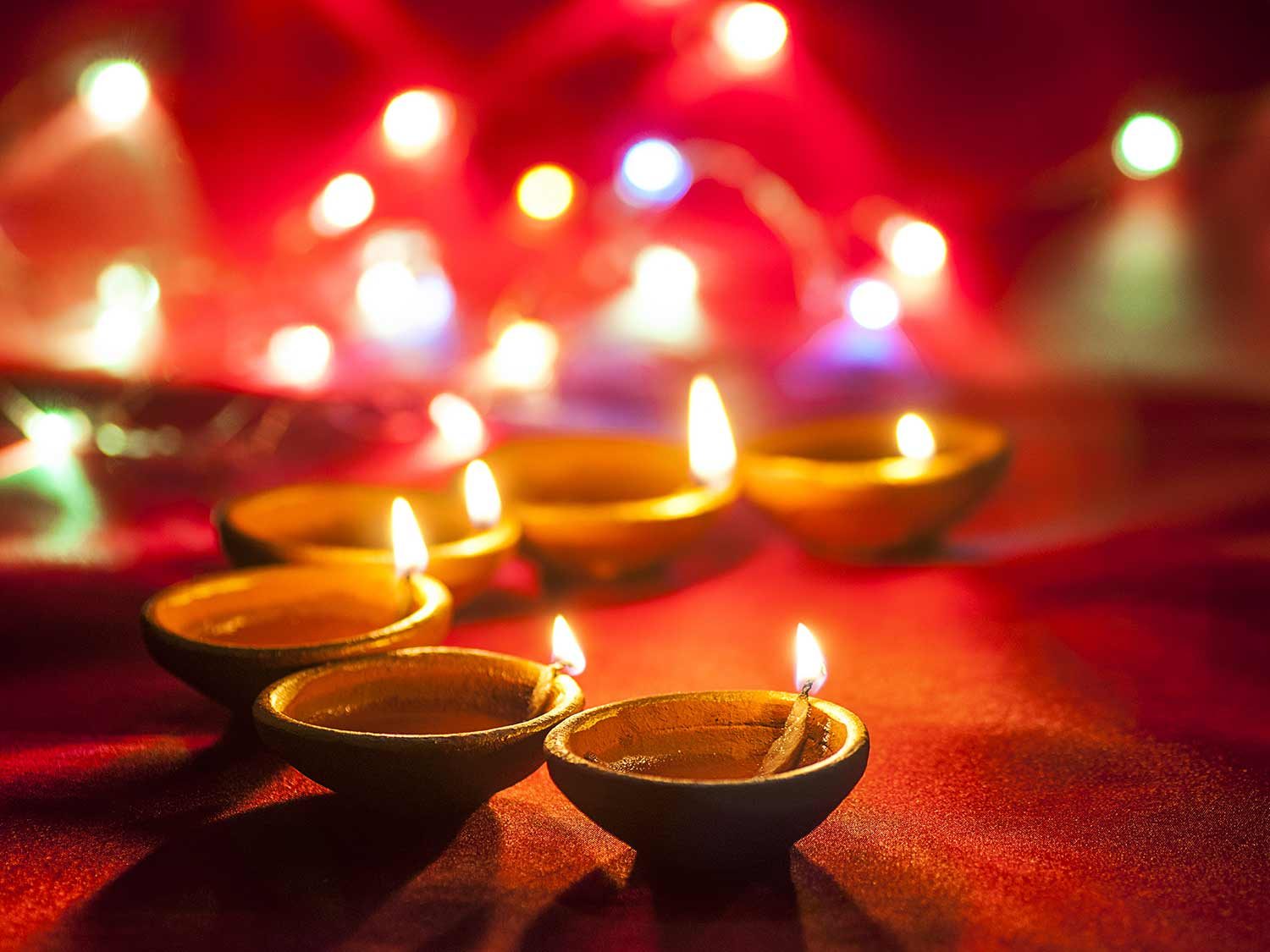
[Photographs: Shutterstock, unless otherwise noted]
Growing up, our household of four would rise early—way too early—on the first day of Diwali, the Hindu “festival of lights.” It was technically a holiday, but we still had to wake up at 7 a.m. While old-timey Hindi film songs played on All India Radio’s early-morning show, and our parents, who had already been up for hours, bustled about the thoroughly cleaned house—Dad placing little earthen oil lamps along the windowsills, Mum drawing elaborate rangoli designs with fine colored sand, flowers, or colored rice near the doorway—my sister and I would blearily call dibs on who would go bathe second, so that the other could grab a few more minutes of sleep. After the bath came a visit to the neighborhood temple in our new clothes, lighting firecrackers, and walking around a city twinkling with lights—Diwali made everything look bright and shiny and filled with the promise of new beginnings.
Diwali is celebrated differently depending on what community you are from and where in India you live, and is associated with a number of rituals and deities, but the most popular origin story is linked to the Hindu mythological epic Ramayana. In a nutshell (there are many, many subplots), a demon king named Ravana kidnaps Sita, the wife of Lord Rama, and is defeated after a long, heroic battle. When Sita and Rama, newly reunited, begin the journey back to their kingdom, the people light rows and rows of oil lamps along the way to guide them; the light symbolizes the triumph of good over evil.
Each day of Diwali has its own theme or tradition, from the burning of an effigy symbolizing Ravana and ceremonies dedicated to Lakshmi, the goddess of prosperity, to events like Bhai Dooj, which celebrates the bond between siblings, and Padwa, dedicated to married couples. Some communities carry out rituals dedicated to the goddess of wisdom, Saraswati, while others consider Diwali the start of a new year.
The one thing that has likely made the early-morning temple visits more bearable for generations of Diwali revelers is the prospect of finally arriving home, shrugging out of the itchy finery, and stuffing your face with heaps and heaps of Diwali-special eats, a dazzling array of sweets and snacks, ideally consumed for all meals, round the clock, for the entire duration of the festival: glass jars filled with chiroti and sev, giant aluminum tins packed with chakli, platter after platter of sweet-spicy chivda, and bottomless bowls of crunchy shankarpali. This Diwali spread is called faraal in Marathi households like ours, but several of these sweet and savory foods are also consumed in other regions of the country, under different names. Some are specific to certain places or communities; others are universally loved.
A one-size-fits-all guide to Diwali favorites is hard to make. Debates about the best and worst snacks can get heated. Still, here is a (somewhat) humble attempt at compiling a list, definitely tainted (or elevated) by personal opinion.
Shankarpali
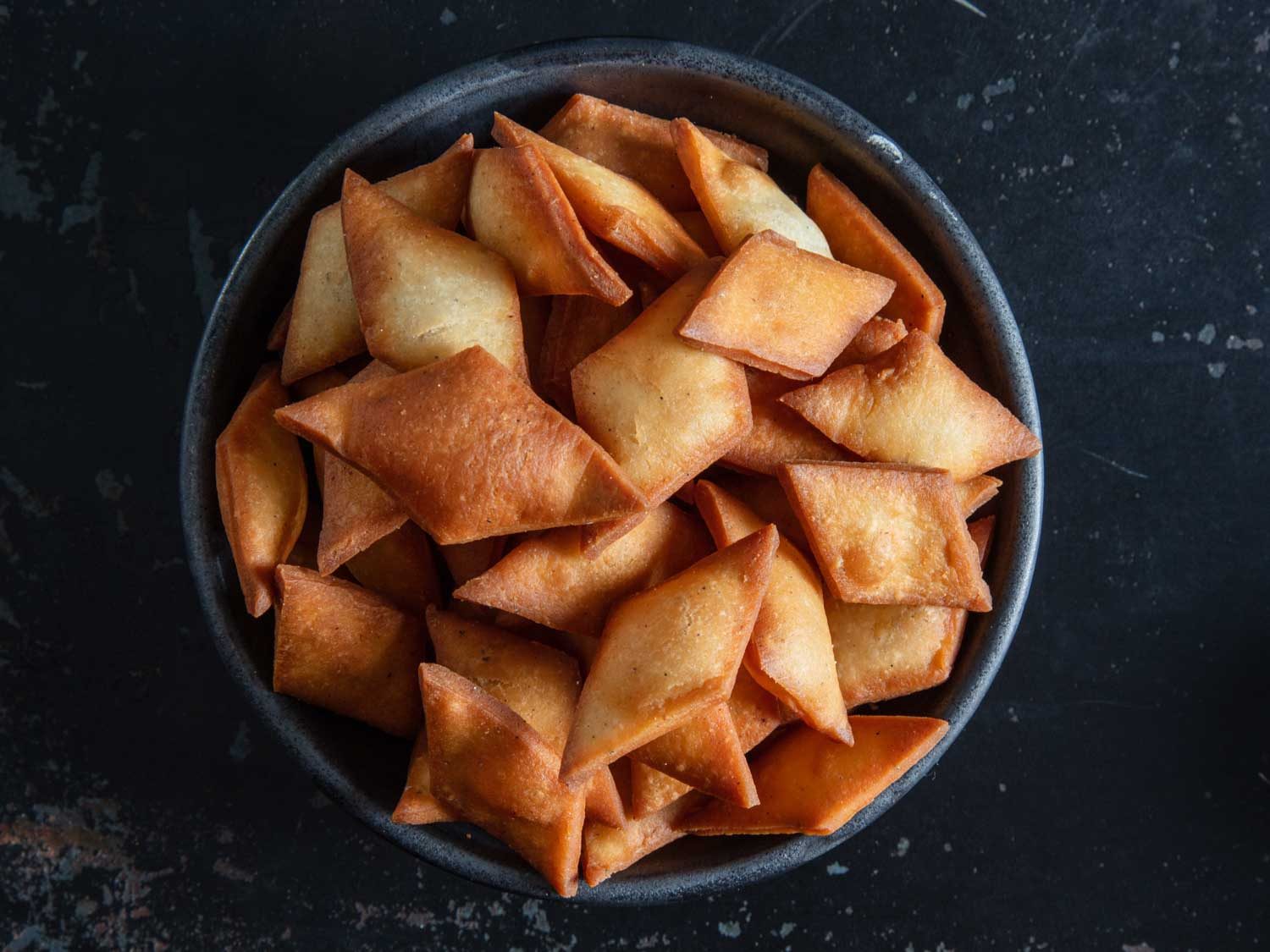
[Photograph: Vicky Wasik]
Shankarpali are the literal best. No, really: Sugary, deep-fried, cardamom-spiked, diamond-shaped munchies, small enough to fit half a dozen in your hand—the minimum amount you need to consume or forever be shamed before the entire pantheon of 360 million Hindu gods. The dough is made from maida, a finely milled wheat flour popular in South Asian countries, similar to cake flour.
Growing up, I’d watch Mum roll out the dough, then carefully slice a pattern of diamonds across it with the edge of the knife before frying them, and beg her to let me try. Plump and crunchy and a gentle golden brown, our stash of shankarpali filled up jar after jar. Now, we buy several packets of them at our favorite neighborhood store, only to inevitably make another trip a couple of days later.
Get the recipe for Shankarpali »
Karanji
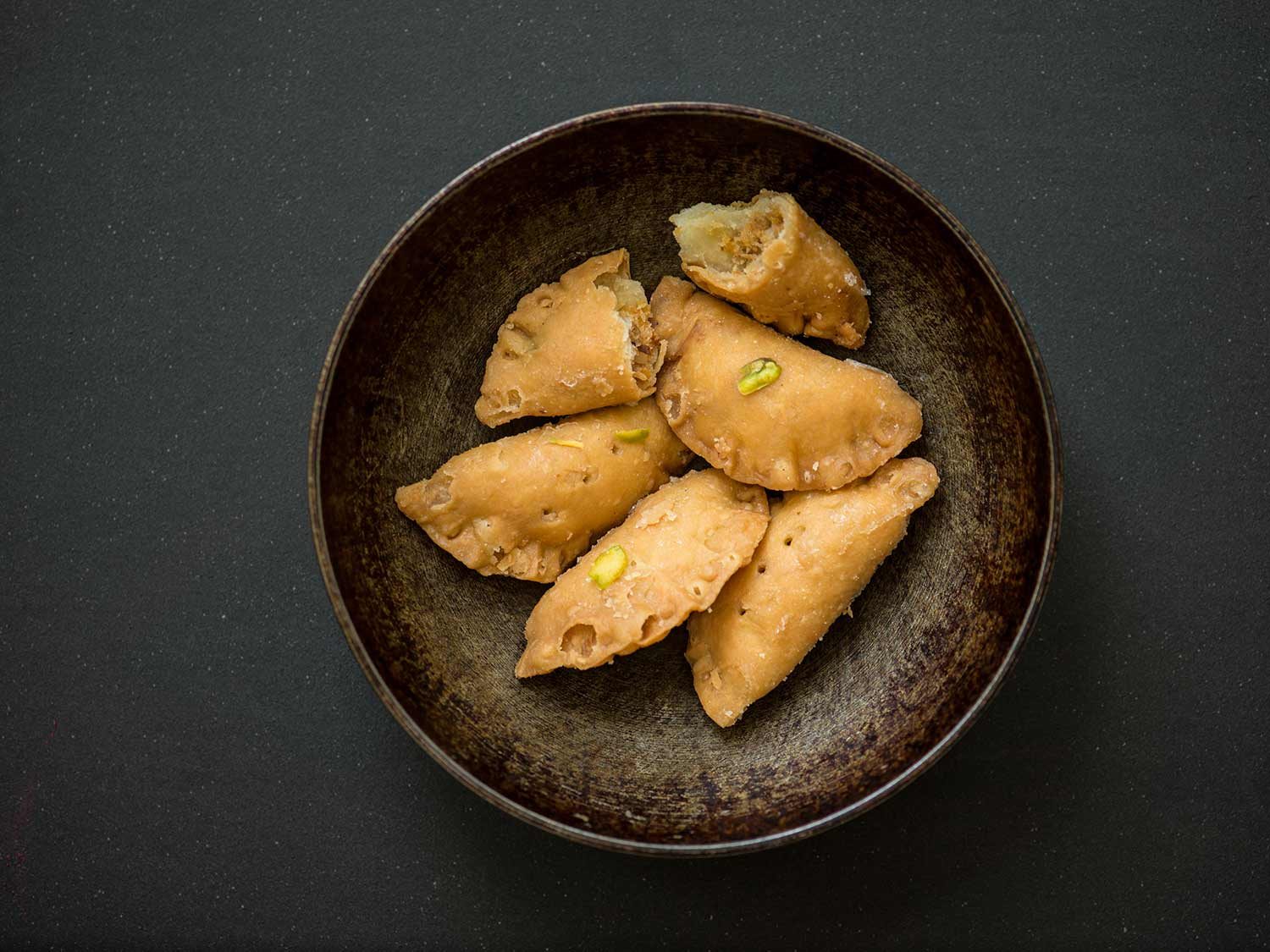
A karanji is a sweet fried dumpling, shaped like a half moon with crimped edges. It’s typically stuffed with desiccated coconut and dried fruit, but the filling can be made with fresh coconut, too. When filled with the latter, a karanji keeps for about a couple of days, which is usually as long as it takes for a massive stock to completely run out in the Phadke household. And, in my humble opinion, honed over three decades of karanji-eating, the fresh, or “wet,” coconut karanji is eminently more delicious.
The thing I like best about karanjis is that their unsweetened crust keeps them from turning into absolute sugar bombs, the way several Indian sweets can be. They’re sweet, but not too sweet, and go perfectly with many rounds of chai on languid Diwali afternoons.
Though karanji is a preparation from the state of Maharashtra, its counterparts can be found in other parts of India. Of these, the gujiya is the most famous, popular in northern India, especially around Uttar Pradesh, Madhya Pradesh, and Rajasthan. It’s stuffed with dried fruit and khoya, a delicious creation made by simmering milk in a large iron pan until the moisture evaporates and the milk solids are left behind. Khoya features in several South Asian sweets, particularly in northern India, and it is often unappetizingly translated to “thickened solidified milk.”
Other iterations include the purukiya from Bihar and ghughra in Gujarat, although, as far as I can tell, they seem to be different in name only. There is also kajjikaya, made in Andhra and Kannada homes, which has a crisper, lighter crust.
Sev
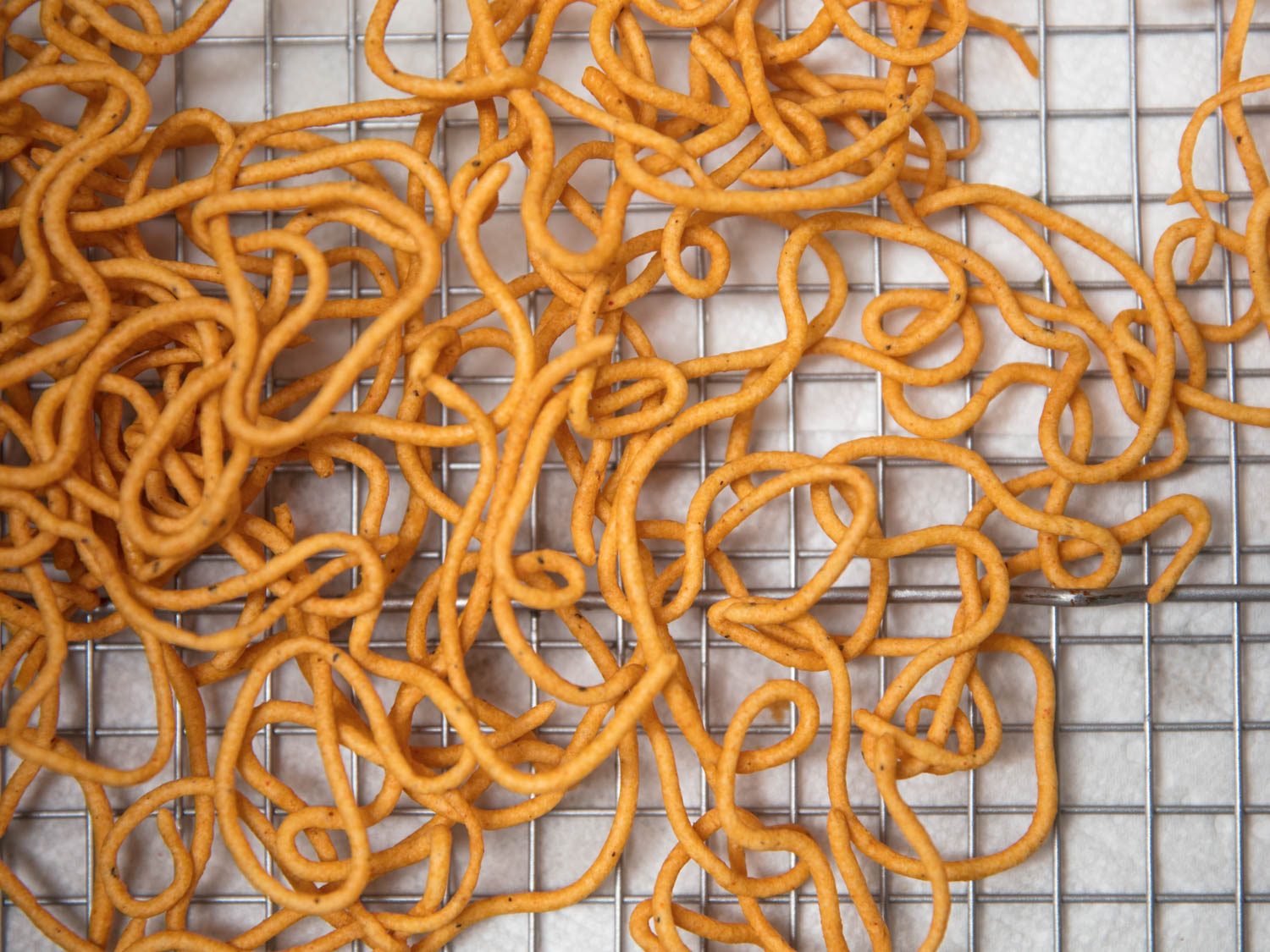
[Photograph: Vicky Wasik]
Think of sev as spicy, crunchy noodles made of besan (gram flour, or a flour made from either raw or roasted ground chickpeas), but broken up into hundreds of little pieces, measuring half an inch or smaller. Ideally, just small enough to eat by the fistful.
There are several kinds of sev across India, varying in thickness, from as thin as cake sprinkles to as thick as cheese straws, and in spice levels. For example, there’s Ratlami sev, which packs a slow, potent burn from black pepper, and the bright-yellow “nylon” sev that’s a popular garnish for chaat or the “masala toast sandwiches” sold on Mumbai’s streets.
The one I’m talking about here, though, is the orange kind, best consumed at home, because in shops you’ll find it all broken up into proper, packageable bits. If you’re making it yourself, however, or have managed to score an invite to the house of someone who is, you’ll get to eat it hot out of the pan, as a giant, crunchy tangle of deliciousness. A nest of flavor! A bouquet of toothsomeness! You get the drift.
Chivda
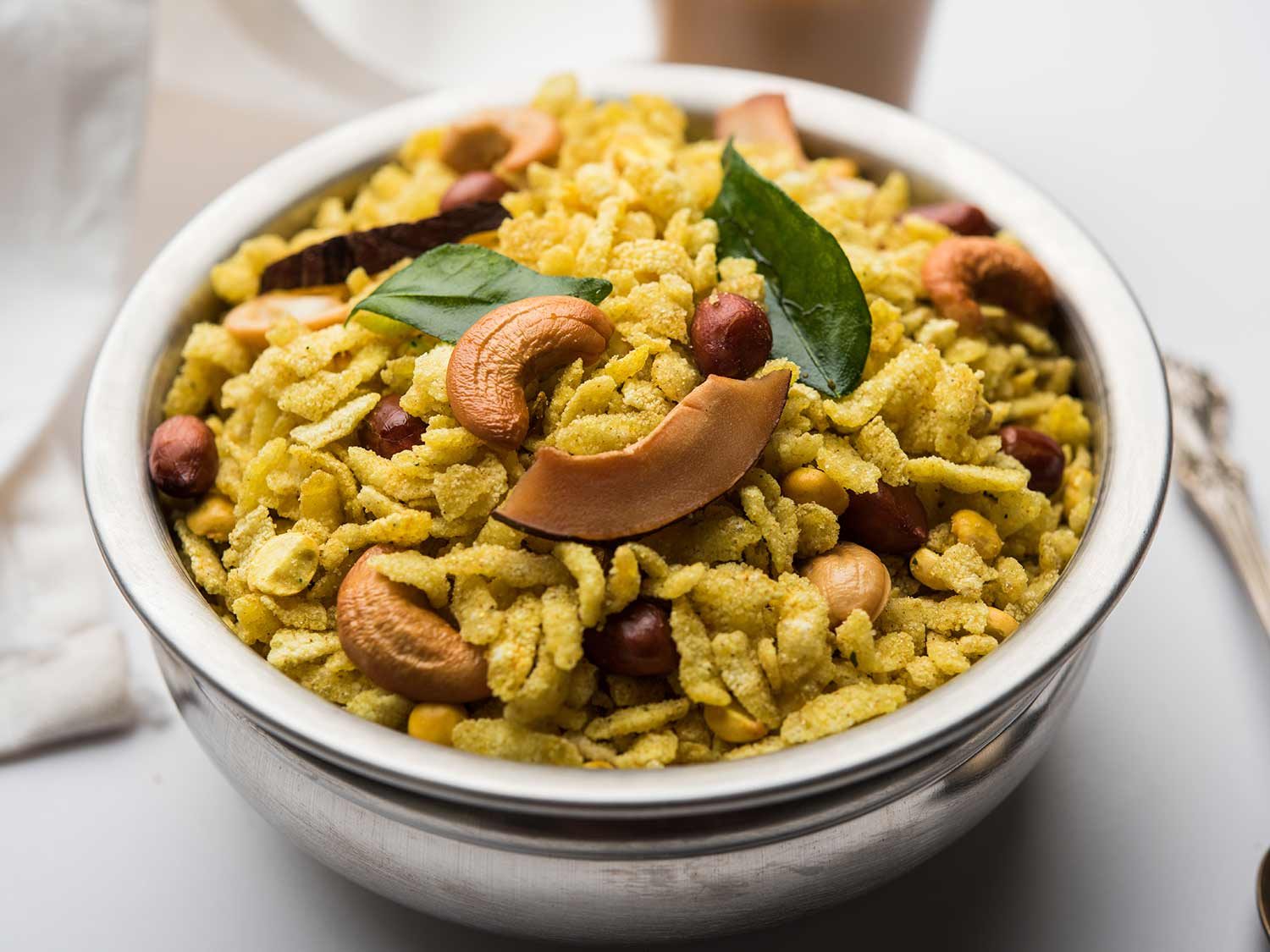
Chivda is similar to “Bombay mix,” an assortment of ingredients like fried lentils, peanuts, fried onion, sev, and curry leaves, though here I’m specifically referring to a version made with beaten rice flakes, or poha. Chivda’s role among Diwali snacks is similar to the one pasta salad plays at American barbecues: You spot it at nearly every single one you attend, but you don’t particularly care for it because, well, there’s so much better stuff around. But if it ever went away, you’d kinda miss it…right? Okay, honestly, I don’t know. I’m not American. But you see what I’m saying?
Chivda is one of those Diwali snacks that nearly always get left over. It’s delicious, don’t get me wrong—crispy and savory, made by first roasting the rice flakes lightly, and then tempering them with whole spices, green chilies, and as many curry leaves as you can possibly find. Add some whole roasted peanuts and fried crunchy bits of coconut, and the whole thing tastes spicy and sweet and salty. It’s actually the perfect accompaniment to all the sweets, except you’re too busy stuffing your face with the karanji and chakli to actually appreciate it in time.
There is also a version made with thin potato straws, called batata chivda. As much as I love potato, the batata chivda is, we must admit, the lesser chivda.
Chakli
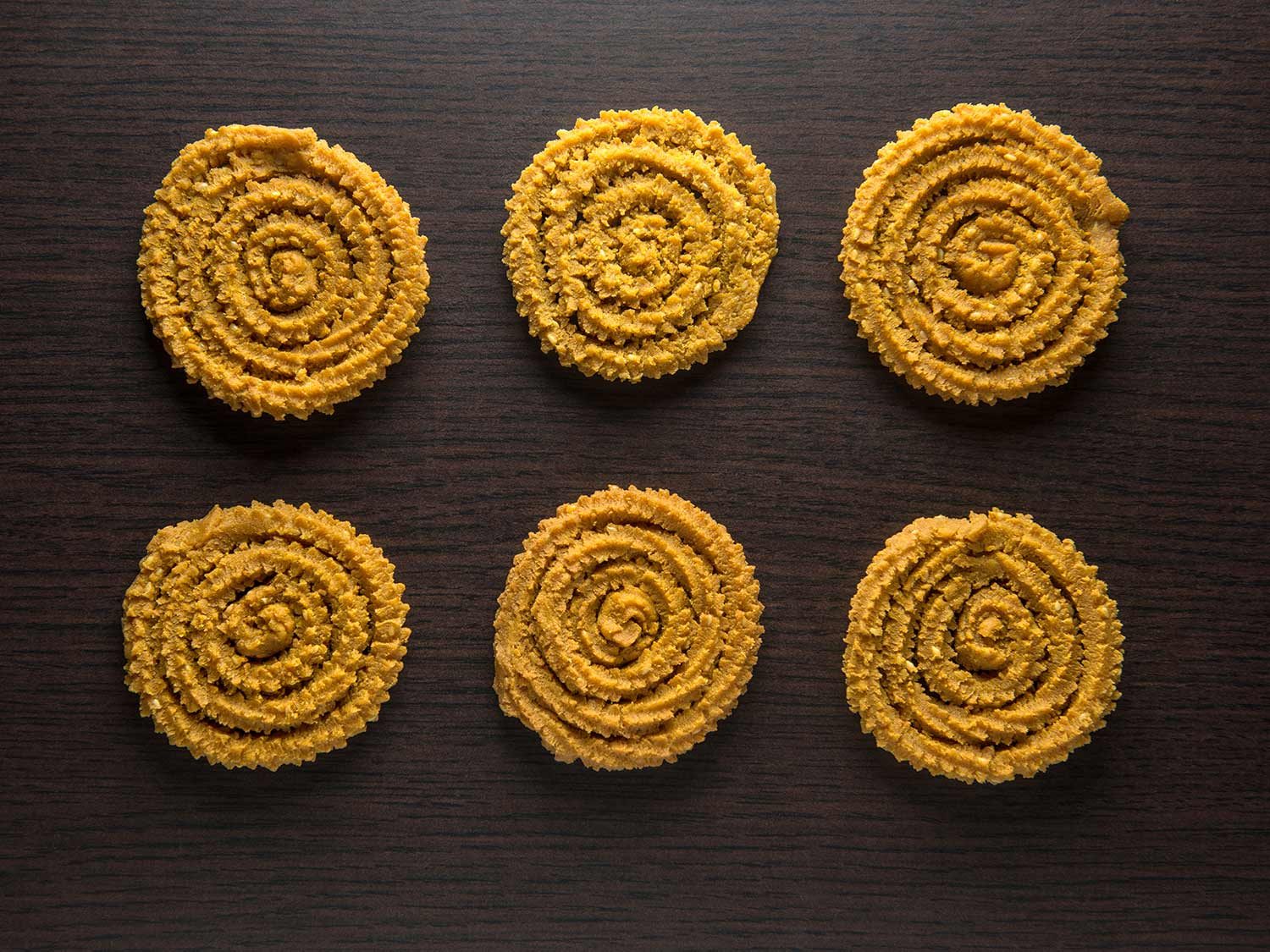
Chaklis are a spiral-shaped, crunchy, savory snack made with an assortment of flours, including chickpea, split black gram, mung bean, and rice, with red chili powder, turmeric, and asafoetida mixed in for seasoning. A similar preparation from South India is named murukku, made from rice and urad dal flour. Chaklis have a pretty long shelf life, and also work well as chakna—assorted snacks eaten as an accompaniment to alcohol. Diwali is also a time for some partying, you know.
Kaju Katli
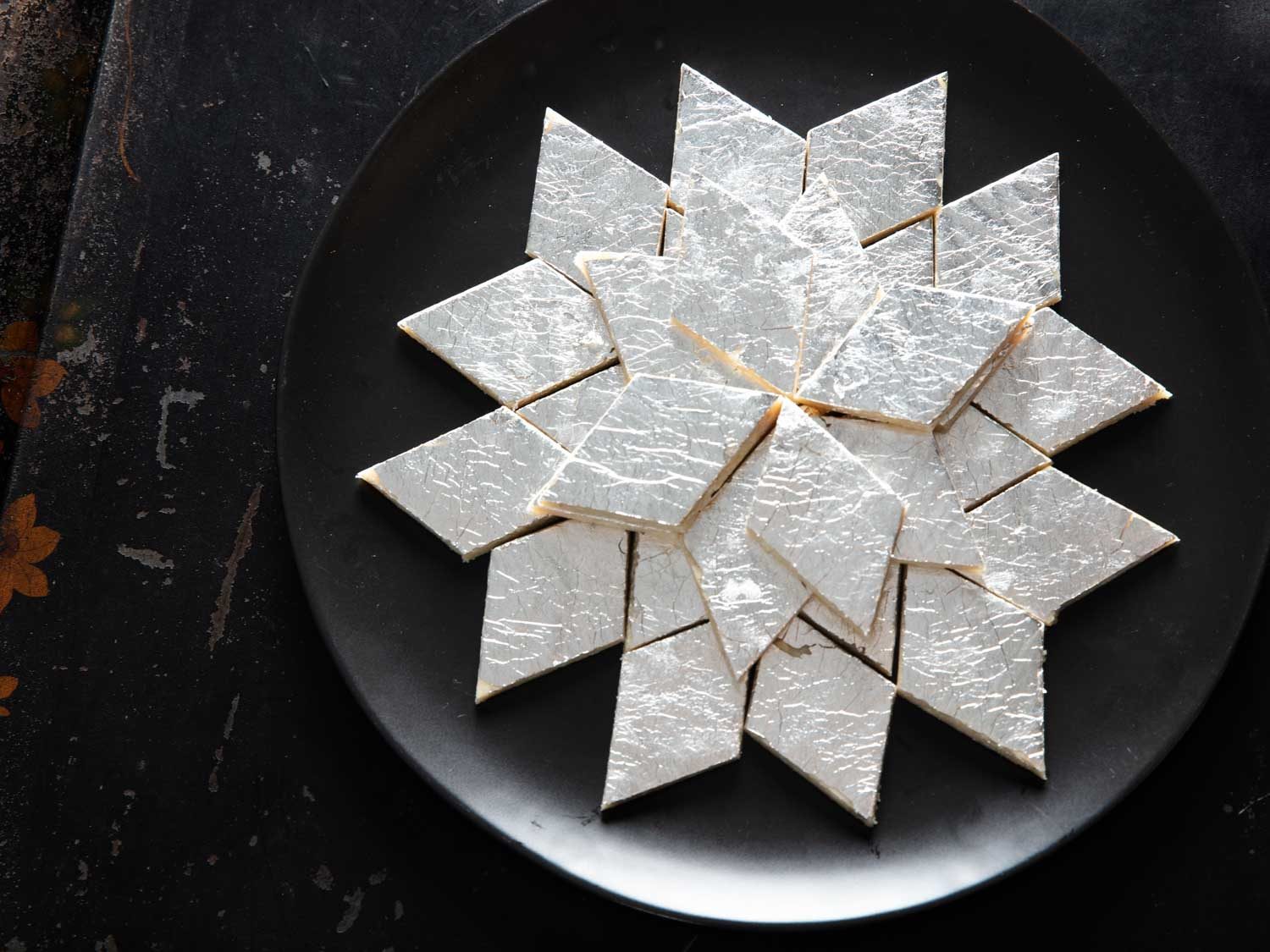
[Photograph: Vicky Wasik]
Kaju katli means a “cashew slice”—a dense, milky sweet made with, well, cashews, cut into diamond-shaped pieces, and topped with edible silver foil known as vark. A blend of ground cashews, milk, and sugar is stirred over the flame until the mixture acquires a dough-like consistency. After it cools, it is kneaded, rolled out, and cut into diamonds.
Like the karanji, the kaju katli is among the less sweet desserts, which may be one of the reasons why it can be a bit…divisive. Haters call it bland chalk powder, but people of good taste know it to be peak-tier in the hierarchy of Indian desserts. Imagine hyping up the frankly overrated soggy mess of syrup that is gulab jamun—irritatingly present at absolutely every single North Indian gathering—while ignoring the understated beauty of the kaju katli. Imagine.
Get the recipe for Kaju Katli »
Jalebi
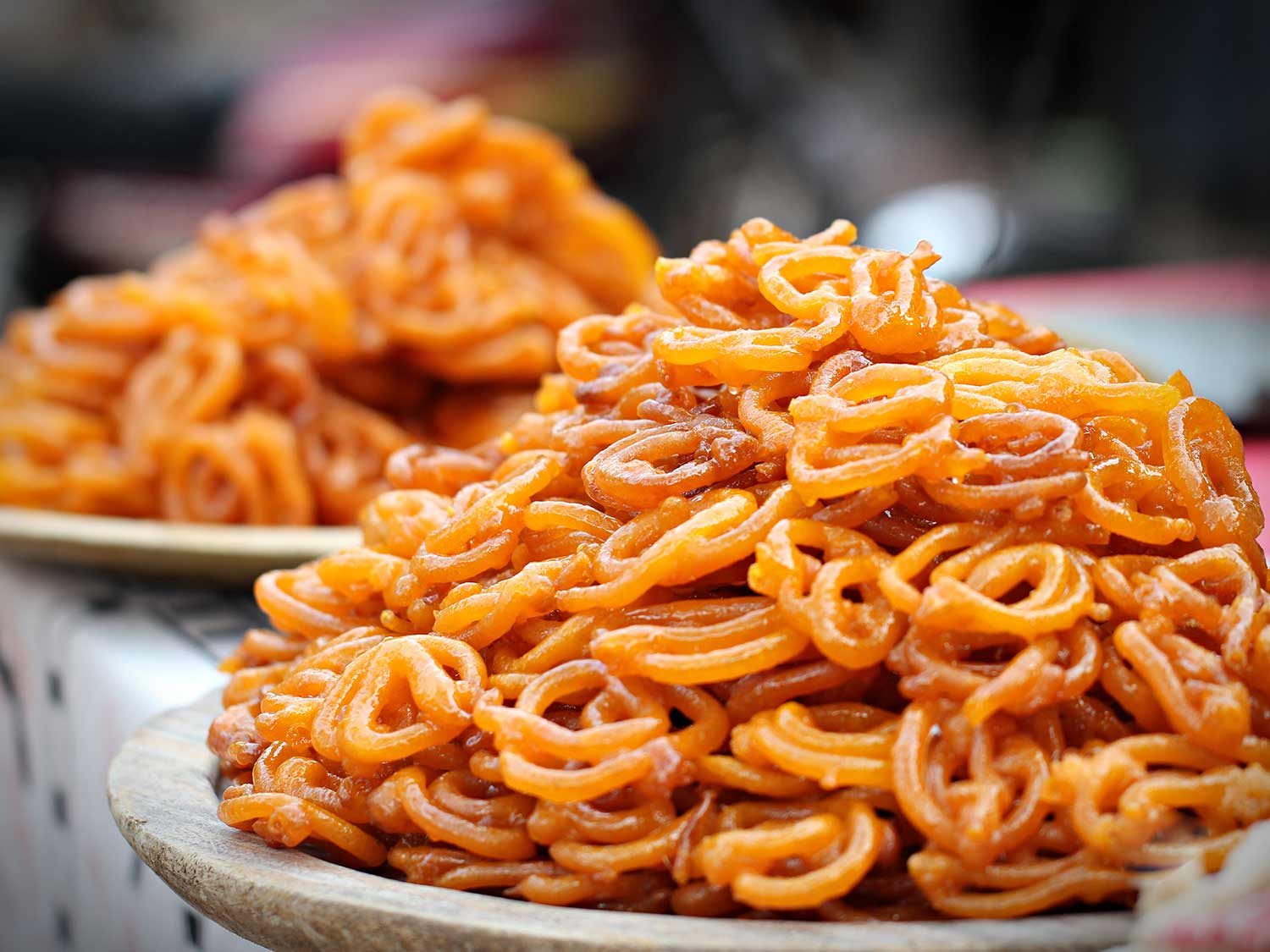
There’s something hypnotic about watching a fresh batch of jalebi being fried. A batter made from maida flour, sugar, saffron, and rose essence is piped out of a muslin cone into a giant pan of hot oil, forming coils of bright-yellow or orange jalebi sizzling on the surface. Once removed from the oil, they are dunked into sugar syrup and sprinkled with saffron or slivered pistachios, and they’re best eaten hot. They have a crackly-chewy texture with a shiny, glazed surface.
Jalebi are often paired with rabri—a dessert made from condensed milk, studded with cardamom, almonds, and pistachios—or with gathiya, a fried savory snack that’s like a thicker version of sev. Or you can just have them on their own, ideally in multiples.
Variations on jalebi include jangiri from South India and imarti from the north. These are pretty much the same, only with different names, although they’re made with ground black gram instead of maida, giving the jalebi a slightly nutty flavor. Jangiri are smaller, softer, chewier, and, arguably, prettier than jalebi. They have perfectly shaped curls around their edges, making them resemble ornate, bright-orange bangles, unlike jalebi, whose shape depends almost entirely on the skill of the cook. Jalebi batter is also fermented overnight to give it a slightly tangier flavor.
Anarsa
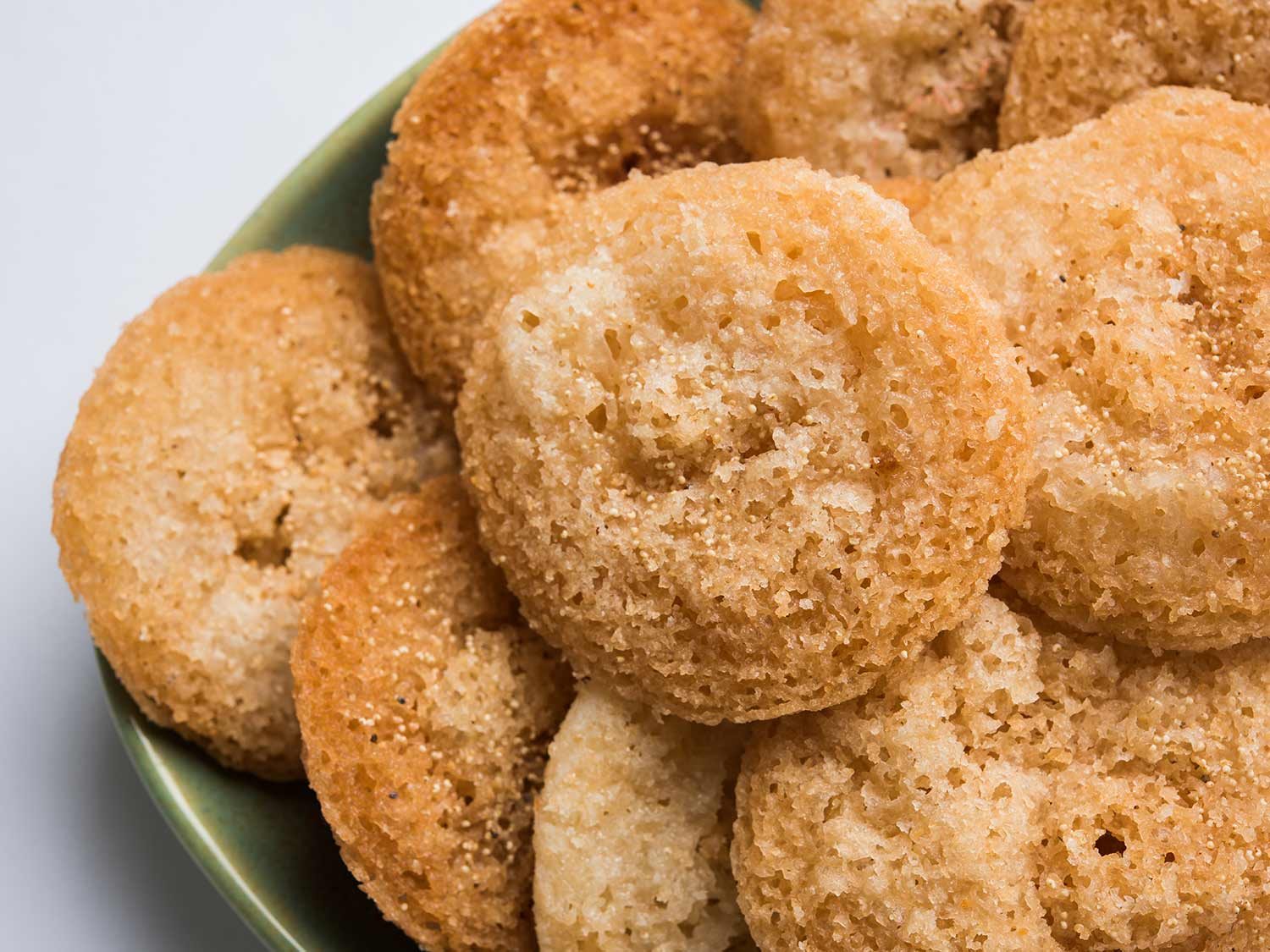
An anarsa is a pastry-like sweet popular in the states of Maharashtra and Bihar. It’s made from soaked powdered rice, sugar or jaggery, poppy seeds, and clarified butter.
Making this is a bit time-consuming. The rice needs to be soaked for two to three days, and the water needs to be changed daily to prevent it from fermenting. The dried, ground rice is known as pithi and is mixed with an equal quantity of jaggery or sugar. The resulting dough, with milk and poppy seeds folded in, is kept covered overnight so it ferments a bit. Then it’s rolled out into small, flat disks, to be fried poppy side up. Bihar’s variation is slightly rounder.
Chiroti/Chirote
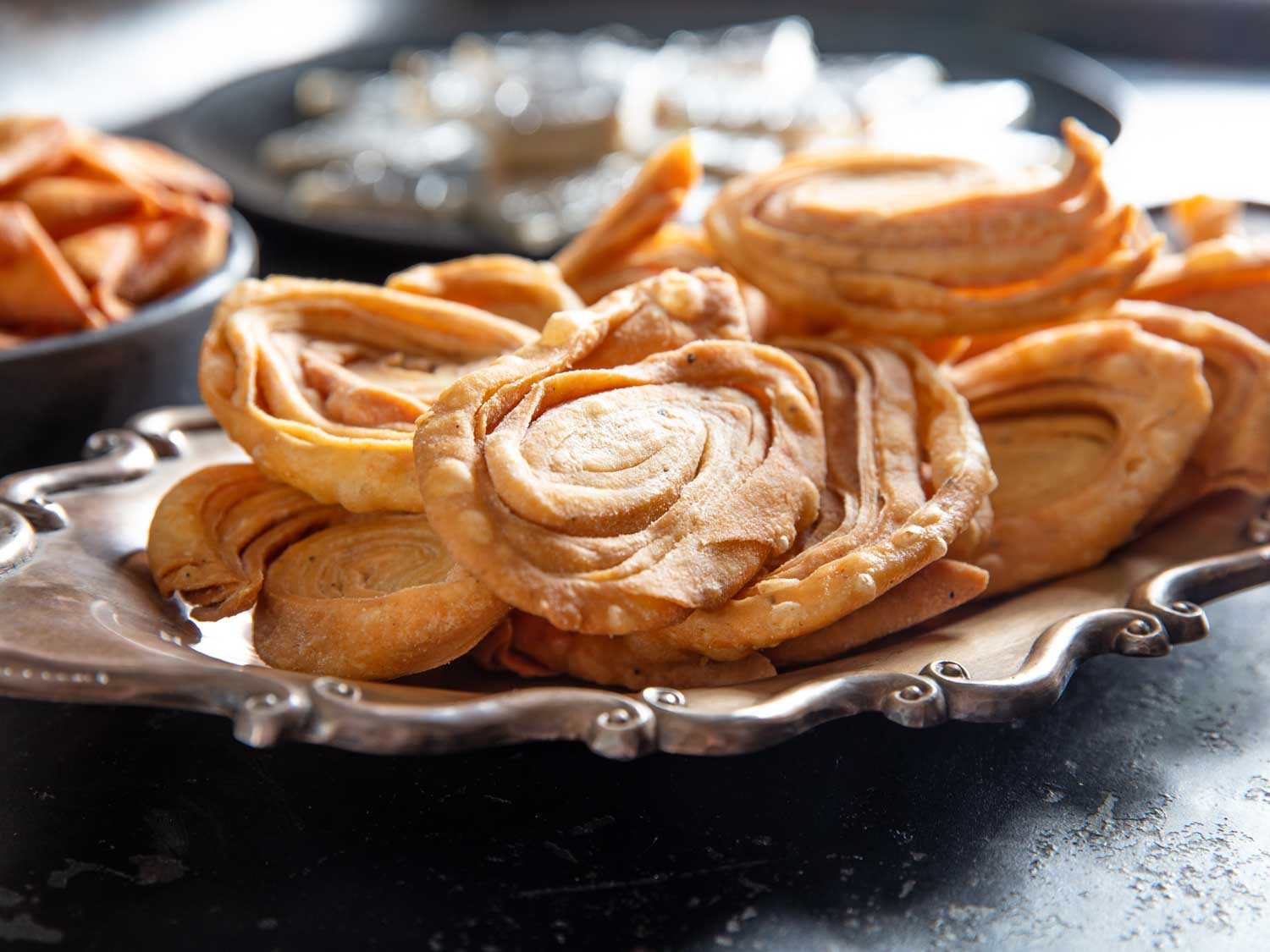
[Photograph: Vicky Wasik]
A chiroti is flaky on the outside and fluffy on the inside, the way only a metric ton of maida flour can make it. Golden brown, it resembles a firmer version of the puri, and also a better one, because it gets sprinkled (very) liberally with powdered sugar and grated almonds. (Though you can also make a savory version, as in the recipe below.) Like shankarpali, best had with way too many rounds of chai.
Get the recipe for Savory Chiroti »
Motichoor Laddoos
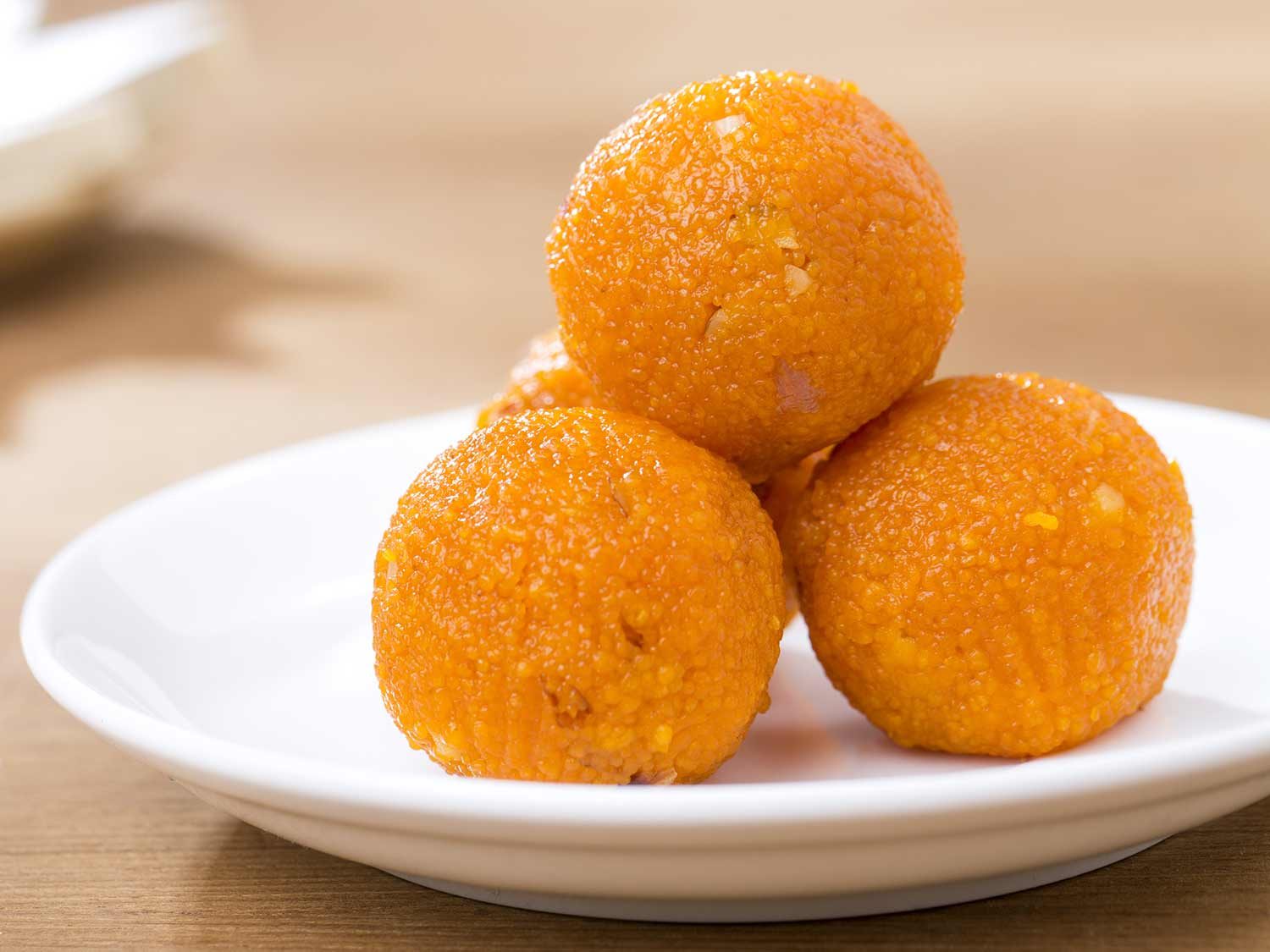
South Asia has a lot of laddoos. No, really. There are just way too many laddoos. Varieties of these spherical sweets include besan laddoos and semolina laddoos and coconut laddoos and everything in between. Growing up, a lot of us also encountered something called nutritious laddoos. These hideous orbs combined oatmeal and fenugreek seeds and jaggery and absolutely anything else that would ensure it did not taste good.
Thankfully, though, laddoos have remained, for the most part, blissfully decadent and thoroughly devoid of any nutritional value—especially motichoor laddoos, the most festive variety. Soft and orange and eminently eatable, motichoor laddoos are made of very tiny balls of gram flour that are deep-fried, soaked in sugar syrup, and compressed together to form larger balls (hence the name motichoor, meaning “crushed pearls”). They’re tooth-shatteringly sweet—a bit grossly so, I admit—but nevertheless they are very, very good.
All products linked here have been independently selected by our editors. We may earn a commission on purchases, as described in our affiliate policy.
Source link